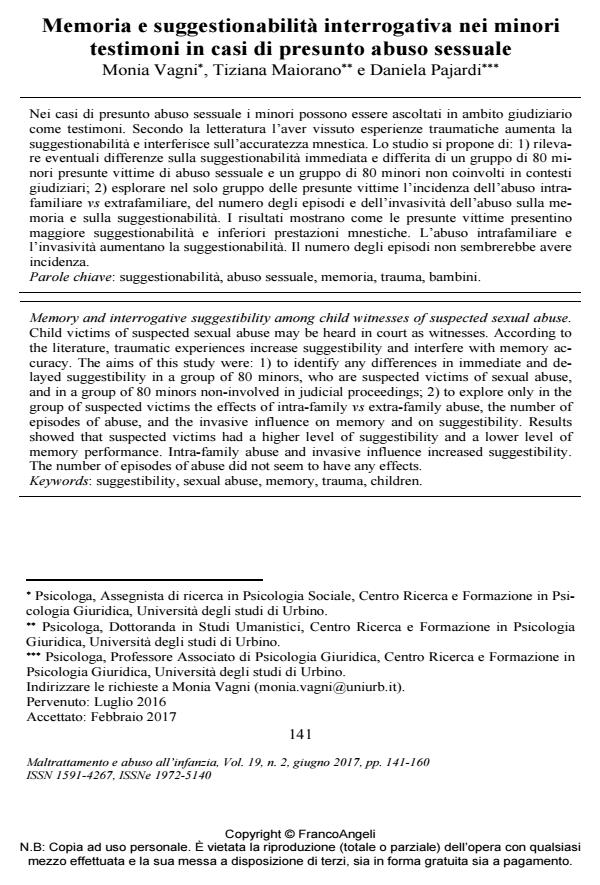Memory and interrogative suggestibility among child witnesses of suspected sexual abuse
Journal title MALTRATTAMENTO E ABUSO ALL’INFANZIA
Author/s Monia Vagni, Tiziana Maiorano, Daniela Pajardi
Publishing Year 2017 Issue 2017/2
Language Italian Pages 21 P. 141-161 File size 254 KB
DOI 10.3280/MAL2017-002008
DOI is like a bar code for intellectual property: to have more infomation
click here
Below, you can see the article first page
If you want to buy this article in PDF format, you can do it, following the instructions to buy download credits

FrancoAngeli is member of Publishers International Linking Association, Inc (PILA), a not-for-profit association which run the CrossRef service enabling links to and from online scholarly content.
Child victims of suspected sexual abuse may be heard in court as witnesses. According to the literature, traumatic experiences increase suggestibility and interfere with memory accuracy. The aims of this study were: 1) to identify any differences in immediate and delayed suggestibility in a group of 80 minors, who are suspected victims of sexual abuse, and in a group of 80 minors non-involved in judicial proceedings; 2) to explore only in the group of suspected victims the effects of intra-family vs extra-family abuse, the number of episodes of abuse, and the invasive influence on memory and on suggestibility. Results showed that suspected victims had a higher level of suggestibility and a lower level of memory performance. Intra-family abuse and invasive influence increased suggestibility. The number of episodes of abuse did not seem to have any effects.
Keywords: Suggestibility, sexual abuse, memory, trauma, children
- Coping Strategies, Immediate and Delayed Suggestibility among Children and Adolescents Tiziana Maiorano, Monia Vagni, in Social Sciences /2020 pp.186
DOI: 10.3390/socsci9110186 - COVID-19: Risk Factors and Protective Role of Resilience and Coping Strategies for Emergency Stress and Secondary Trauma in Medical Staff and Emergency Workers—An Online-Based Inquiry Tiziana Maiorano, Monia Vagni, Valeria Giostra, Daniela Pajardi, in Sustainability /2020 pp.9004
DOI: 10.3390/su12219004 - The Role of Coping Strategies in Children’s Repeated Suggestive Interviews Monia Vagni, Valeria Giostra, in Forensic Sciences /2024 pp.221
DOI: 10.3390/forensicsci4020015 - Evaluating autobiographical skills and their relationship with suggestibility in children: development and validation of the Children Recalling Autobiographical Memory Monia Vagni, Valeria Giostra, Luca Simione, in Frontiers in Psychology 1321305/2024
DOI: 10.3389/fpsyg.2024.1321305 - Attachment, Trauma, and Mentalization in Intimate Partner Violence: A Preliminary Investigation Valeria Condino, Guido Giovanardi, Monia Vagni, Vittorio Lingiardi, Daniela Pajardi, Antonello Colli, in Journal of Interpersonal Violence /2022 pp.NP9249
DOI: 10.1177/0886260520980383 - The relationship between coping strategies, resistant responses, and suggestibility in children Monia Vagni, Tiziana Maiorano, Valeria Giostra, Daniela Pajardi, Ray Bull, in Psychology, Crime & Law /2025 pp.1
DOI: 10.1080/1068316X.2025.2466092 - Effects of post-traumatic stress disorder on interrogative suggestibility in minor witnesses of sexual abuse Monia Vagni, Tiziana Maiorano, Daniela Pajardi, in Current Psychology /2022 pp.7681
DOI: 10.1007/s12144-020-01253-7 - The relationship between trauma symptoms and immediate and delayed suggestibility in children who have been sexually abused Gisli Gudjonsson, Monia Vagni, Tiziana Maiorano, Daniela Pajardi, in Journal of Investigative Psychology and Offender Profiling /2020 pp.250
DOI: 10.1002/jip.1554 - Trauma symptoms of sexual abuse reduce resilience in children to give ‘no’ replies to misleading questions Gisli Gudjonsson, Monia Vagni, Tiziana Maiorano, Valeria Giostra, Daniela Pajardi, in Personality and Individual Differences 110378/2021 pp.110378
DOI: 10.1016/j.paid.2020.110378
Monia Vagni, Tiziana Maiorano, Daniela Pajardi, Memoria e suggestionabilità interrogativa nei minori testimoni in casi di presunto abuso sessuale in "MALTRATTAMENTO E ABUSO ALL’INFANZIA" 2/2017, pp 141-161, DOI: 10.3280/MAL2017-002008